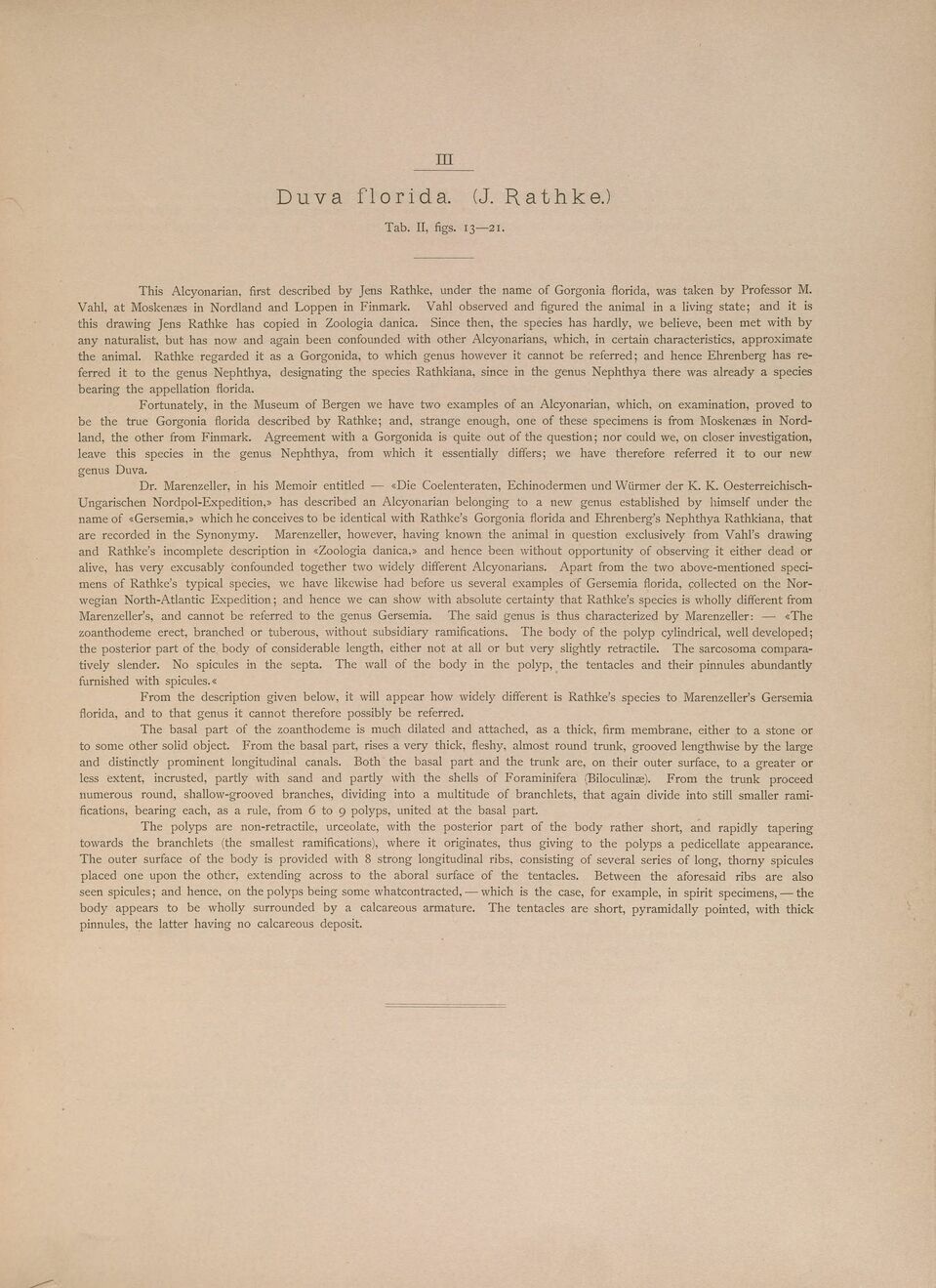
Full resolution (JPEG) - On this page / på denna sida - Sidor ...

<< prev. page << föreg. sida << >> nästa sida >> next page >>
Below is the raw OCR text
from the above scanned image.
Do you see an error? Proofread the page now!
Här nedan syns maskintolkade texten från faksimilbilden ovan.
Ser du något fel? Korrekturläs sidan nu!
This page has never been proofread. / Denna sida har aldrig korrekturlästs.
III
Duva flo rida. (J. Rathke.)
Tab. II, figs. 13—21.
This Alcyonarian, first described by Jens Rathke, under the name of Gorgonia florida, was taken by Professor M.
Vahl, at Moskenæs in Nordland and Loppen in Finmark. Vahl observed and figured the animal in a living state; and it is
this drawing Jens Rathke has copied in Zoologia danica. Since then, the species has hardly, we believe, been met with by
any naturalist, but has now and again been confounded with other Alcyonarians, which, in certain characteristics, approximate
the animal. Rathke regarded it as a Gorgonida, to which genus however it cannot be referred; and hence Ehrenberg has
referred it to the genus Nephthya, designating the species Rathkiana, since in the genus Nephthya there was already a species
bearing the appellation florida.
Fortunately, in the Museum of Bergen we have two examples of an Alcyonarian, which, on examination, proved to
be the true Gorgonia florida described by Rathke; and, strange enough, one of these specimens is from Moskenæs in
Nordland, the other from Finmark. Agreement with a Gorgonida is quite out of the question; nor could we, on closer investigation,
leave this species in the genus Nephthya, from which it essentially differs; we have therefore referred it to our new
genus Duva.
Dr. Marenzeller, in his Memoir entitled — «Die Coelenteraten, Echinodermen und Würmer der K. K.
Oesterreichisch-Ungarischen Nordpol-Expedition,» has described an Alcyonarian belonging to a new genus established by himself under the
name of «Gersemia,» which he conceives to be identical with Rathke’s Gorgonia florida and Ehrenberg’s Nephthya Rathkiana, that
are recorded in the Synonymy. Marenzeller, however, having known the animal in question exclusively from Vahl’s drawing
and Rathke’s incomplete description in «Zoologia danica,» and hence been without opportunity of observing it either dead or
alive, has very excusably confounded together two widely different Alcyonarians. Apart from the two above-mentioned
specimens of Rathke’s typical species, we have likewise had before us several examples of Gersemia florida, collected on the
Norwegian North-Atlantic Expedition; and hence we can show with absolute certainty that Rathke’s species is wholly different from
Marenzeller’s, and cannot be referred to the genus Gersemia. The said genus is thus characterized by Marenzeller: — «The
zoanthodeme erect, branched or tuberous, without subsidiary ramifications. The body of the polyp cylindrical, well developed;
the posterior part of the, body of considerable length, either not at all or but very slightly retractile. The sarcosoma
comparatively slender. No spicules in the septa. The wall of the body in the polyp, the tentacles and their pinnules abundantly
furnished with spicules.«
From the description given below, it will appear how widely different is Rathke’s species to Marenzeller’s Gersemia
florida, and to that genus it cannot therefore possibly be referred.
The basal part of the zoanthodeme is much dilated and attached, as a thick, firm membrane, either to a stone or
to some other solid object. From the basal part, rises a very thick, fleshy, almost round trunk, grooved lengthwise by the large
and distinctly prominent longitudinal canals. Both the basal part and the trunk are, on their outer surface, to a greater or
less extent, incrusted, partly with sand and partly with the shells of Foraminifera (Biloculinæ). From the trunk proceed
numerous round, shallow-grooved branches, dividing into a multitude of branchlets, that again divide into still smaller
ramifications, bearing each, as a rule, from 6 to 9 polyps, united at the basal part.
The polyps are non-retractile, urceolate, with the posterior part of the body rather short, and rapidly tapering
towards the branchlets (the smallest ramifications), where it originates, thus giving to the polyps a pedicellate appearance.
The outer surface of the body is provided with 8 strong longitudinal ribs, consisting of several series of long, thorny spicules
placed one upon the other, extending across to the aboral surface of the tentacles. Between the aforesaid ribs are also
seen spicules; and hence, on the polyps being some whatcontracted, — which is the case, for example, in spirit specimens, — the
body appears to be wholly surrounded by a calcareous armature. The tentacles are short, pyramidally pointed, with thick
pinnules, the latter having no calcareous deposit.
<< prev. page << föreg. sida << >> nästa sida >> next page >>